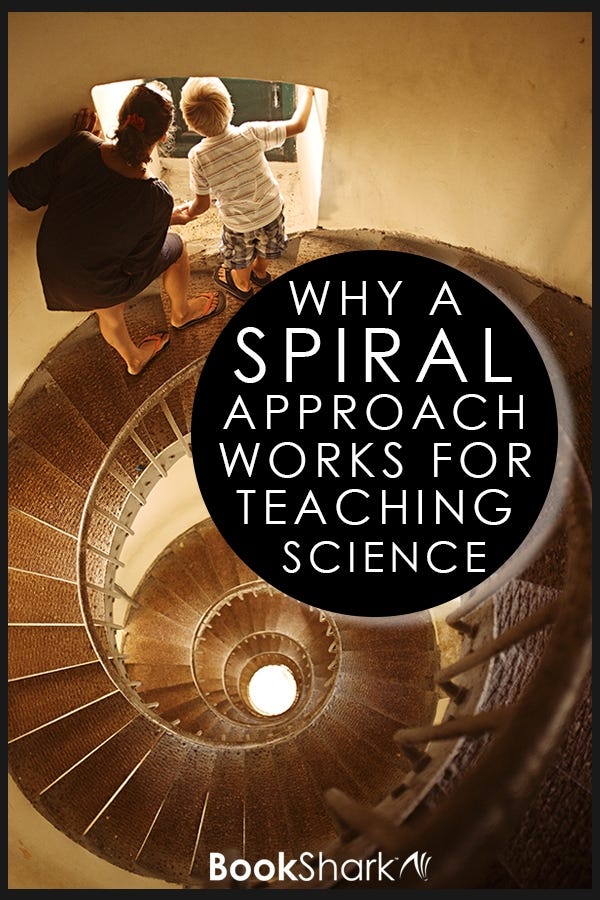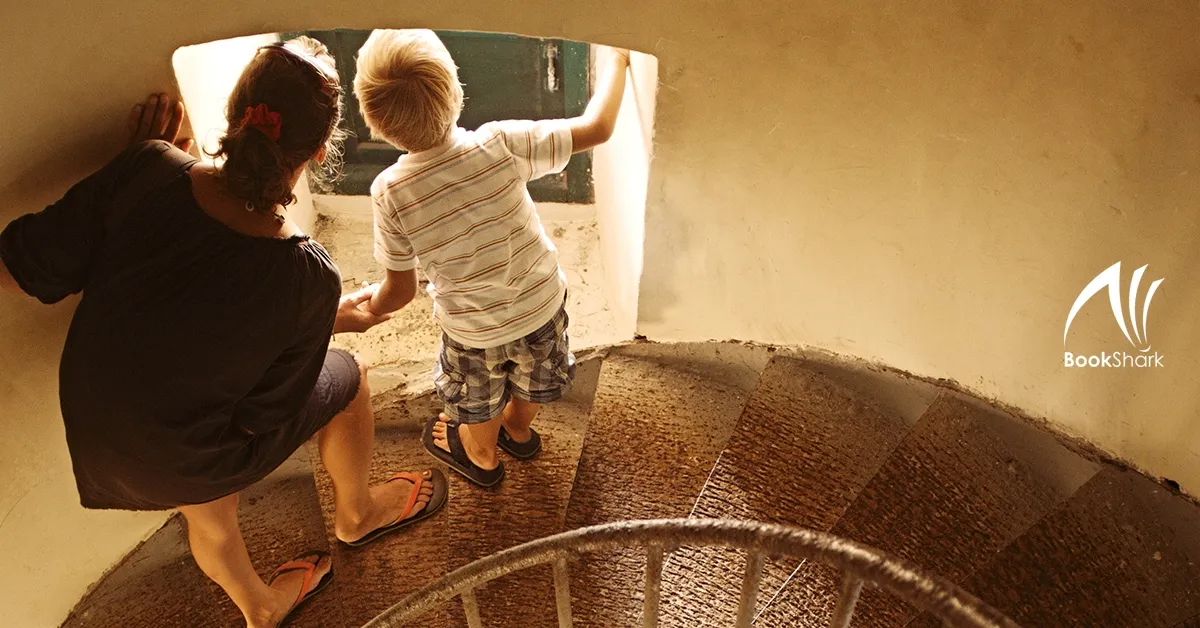As a child, you probably found yourself twisting the spiral that bound your notebook together, watching it circle through the holes down the side of the paper. It looped through a hole then through the next, over and over again all the way up the page. The spiral is a bit mesmerizing to both the eye and the touch. In education, we use the analogy of a spiral to describe a type of teaching.
A spiral approach to teaching means students circle back to learn about topics multiple times throughout their education, allowing them to remember more at a greater depth as they advance through their studies. BookShark Science uses this spiral technique.
The Spiral Approach to Teaching
Think about how students learn addition in their first years of school. They begin by adding one digit to one digit. Then they add multiple digits together. As they grow older, they continue to add larger numbers and progress to multiplication—which is a way to add numbers more quickly.
Each time they learn a new skill, the original skill is still used, but at a higher and more complex level. This is spiral learning.
Cognitive theorist Jerome Bruner wrote, “We begin with the hypothesis that any subject can be taught in some intellectually honest form to any child at any stage of development.”
With a spiral approach, students encounter various topics and concepts multiple times with increasing complexity as they mature. As a result, they will review what they’ve already learned as well as adding new information and understanding as they progress through their studies.
Why a Spiral Approach Works
Spiral teaching capitalizes on the natural way we learn. We begin with basic knowledge and add to that knowledge over time. We’re able to handle more difficult and complex knowledge because we already have experience with the subject and know the basics. We still need to access what we learned in the beginning, though we may not even be aware we are doing it since it’s now second nature.
Think through the process of learning to cook. You probably didn’t begin with Juia Child’s Boeuf Bourguignon!
Instead you learned how to measure ingredients, maybe even as a child. You started out with simple recipes like scrambled eggs and grilled cheese and learned more techniques and tricks over time. Then one day, years later, you were ready to tackle much more time consuming and difficult recipes—homemade yeast bread and marinated, grilled meats.
And yet, you still need to measure most of the time. At this point, though, the measuring is like second nature and doesn’t take much thought on your part. You may even know instinctively how much a teaspoon or tablespoon is without even getting out the measuring spoons.
That’s because you learned to cook using a spiral approach.
The Spiral Approach in BookShark Science
Science study should build upon the natural curiosity of children, helping them to discover and explore the world around them. With a spiral approach, students won’t simply study one science subject in a year. They’ll encounter a variety of science topics, keeping their interest high while taking advantage of the benefits of coming back again to a subject.
With BookShark Science, students from Kindergarten through middle school will encounter Earth, space, life, health, physical, and technological sciences multiple times through their years of study using great literature and hands-on activities.
Introduces Topics in a Simple Form

With a literature-based approach, even a kindergartner will begin to grasp basic concepts of science. Children’s authors are incredible at taking complex scientific concepts and explaining them in an understandable way.
Teaching tip: If you want to introduce a difficult topic even to older students, start with a children’s book on the topic!
Builds on What Students Already Know
Because students see the same topics multiple times over the years, they won’t have to start at the beginning each time. That’s why young children often start by learning math facts: as they move on to more difficult problems, they aren’t struggling to add two digits together. A solid foundation provides a place to build future learning.
Reinforces Previous Learning
Each time a student encounters the various science subjects, they will need to draw upon the concepts they’ve already learned. Their understanding increases over time as they see it applied in a variety of contexts.
Helps Students Store Information in Long Term Memory
When you were in school, did you ever cram for a test the next day, only to find you didn’t remember much of the information a few weeks later? Or maybe you took several years of a foreign language class, yet only recall a few words today? When we don’t use what we know by doing it repeatedly, we won’t remember it over time. With a spiral approach, children revisit and use what they are learning multiple times over the years, so they really learn it.
Keeps Learning Interesting and Engaging
- When children stay at a basic level and are never challenged, they eventually lose interest.
- When children only study one thing, they eventually lose interest.
- When children encounter the information in only one way, they eventually lose interest.
You get the idea. To keep learning fascinating, children need increased depth and complexity, variety, and multiple experiences. The spiral approach of BookShark Science addresses all of these needs.
Try BookShark Science Today
BookShark provides you with everything you need to teach science with a spiral approach including:
- Instructor’s Guides that lay out exactly what you need to do each day with a flexible, four-day schedule.
- Activity sheets for students with hundreds of activities, illustrations, charts, and pictures to solidify your student’s understanding of scientific topics.
- Hands-on activities and experiments that are easy to do with our Science Supplies Kit. You aren’t caught not having what you need.
If you want your students to understand science and enjoy it, have a solid foundation for their high school science studies, and truly learn science—not just memorize facts only to forget them quickly—use a spiral approach. BookShark gives parents and students everything they need to build a strong foundation.
